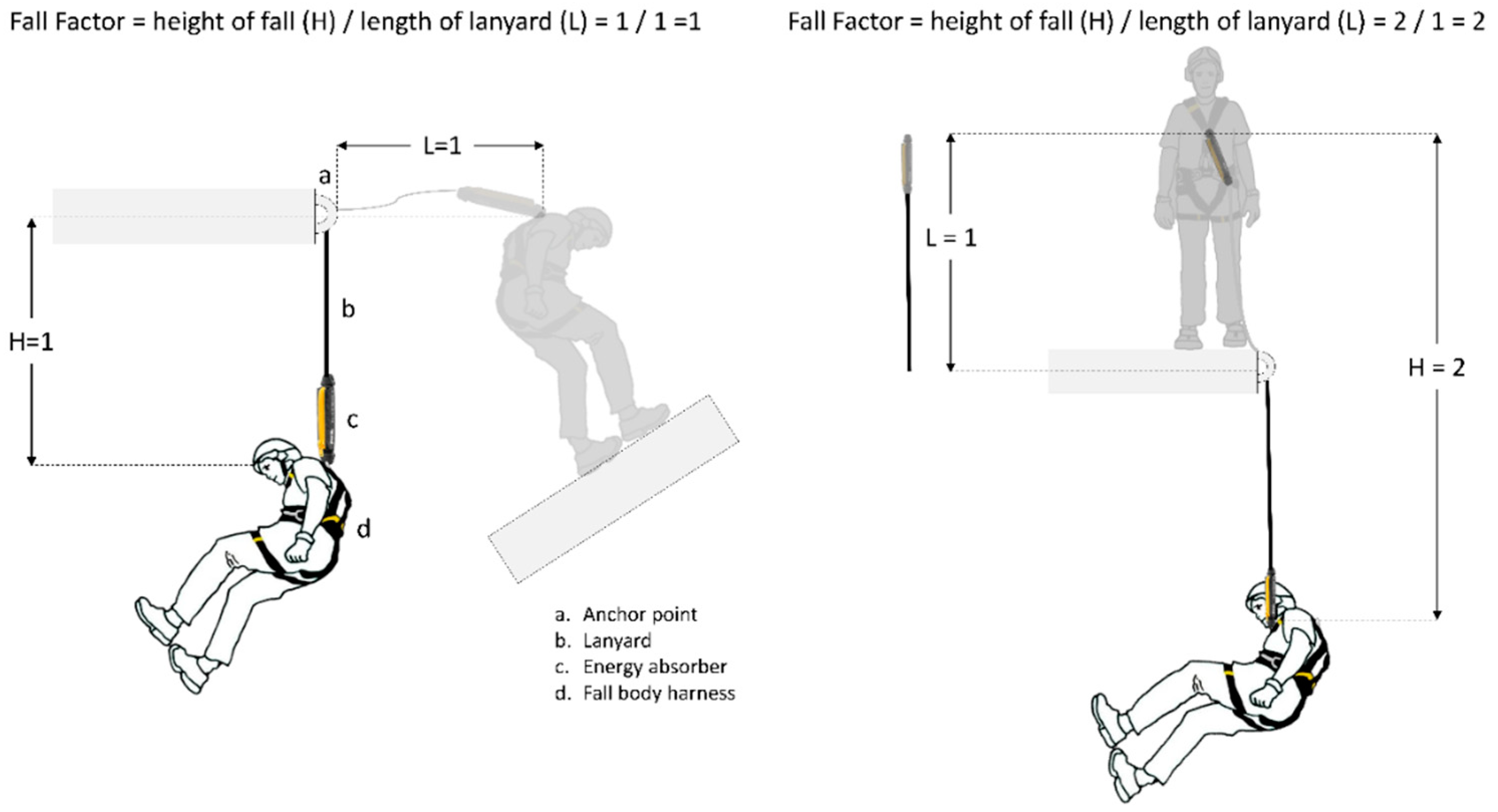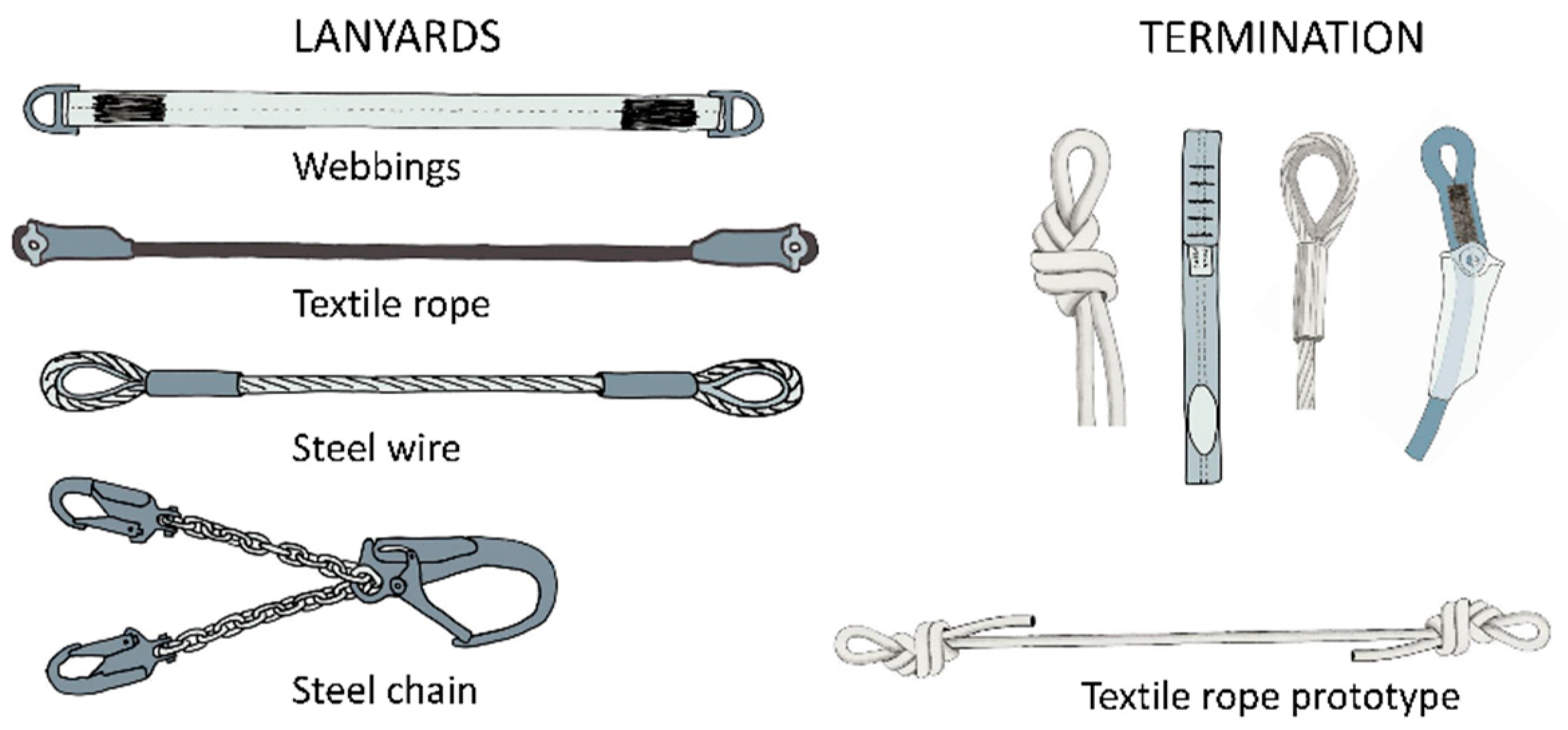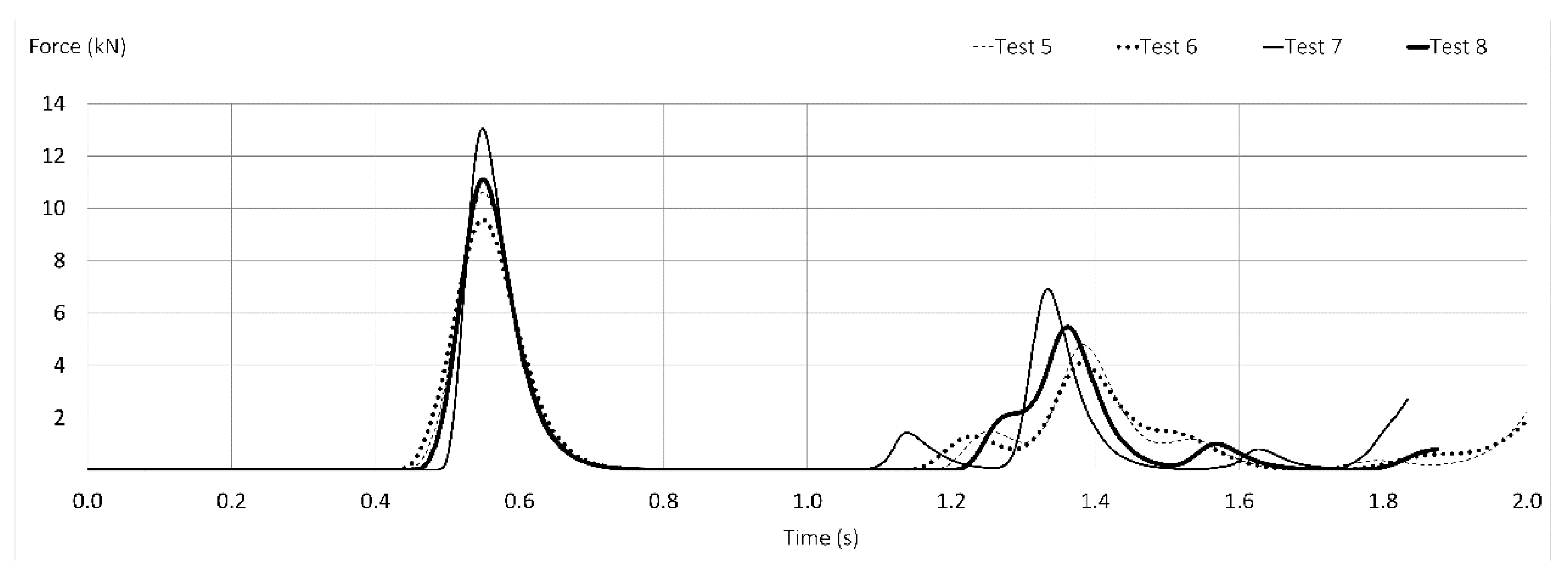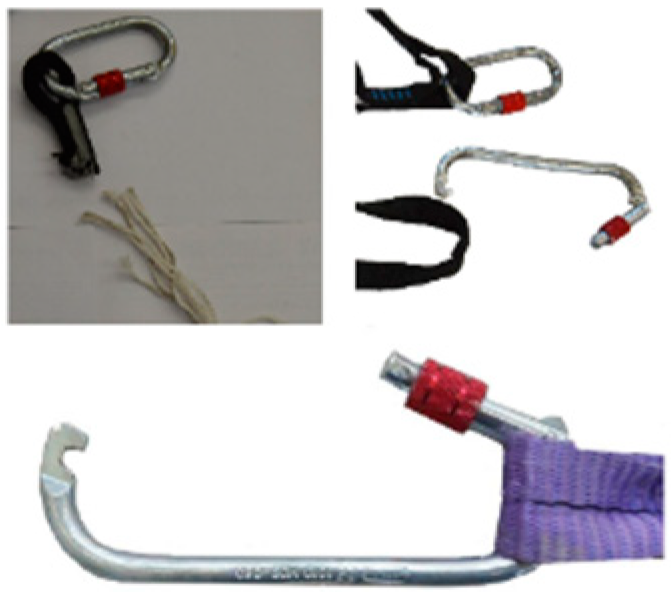1. Introduction
Falls from a height are the main causes of serious and fatal workplace accidents in almost every country. In the USA [
1], fatal workplace injuries from falls, slips and trips have continued a general upward trend, with an increase of 6 percent, and an overall increment of 25 percent in the last 10 years. A study of occupational activity fatalities per year in different countries describes quite a similar scenario. Generally speaking, the year 2016 showed an increase in fatalities of over 25 percent in production sectors, such as roofers, carpenters, tree trimmers and others. In the United Kingdom [
2], the statistics for the construction sector show that falls from a height have represented roughly 50 percent of the total fatal accidents.
Taking the construction sector in the USA as a reference, accidents due to falls from heights are the cause of the greatest number of deaths for the years 1990 and 2001. These accidents seem to correlate with the number of workers in the sector [
3]. This trend persisted in the period between 1997 and 2012, where accidents due to falls from heights went from 36.3 percent in the Huang study [
3] to 44.6 [
4]. In Australia [
5], the fall-from-height fatality rate was 14 percent in 2016, and was only surpassed by motor collision casualties. In Singapore [
6], falls from heights have been the greatest cause of fatal injuries—31.9 percent—in the last ten years. In Spain [
7], statistics for the year 2017 reveal that construction sector accidents represent 17.66 percent of all serious accidents, of which 10.64 percent end in the workers’ deaths. Specifically, to reduce the number of accidents due to falls from heights, the correct use of fall protection equipment is indispensable [
8,
9,
10]. Currently, the use of personal protective equipment (PPE) against falls remains a pending subject. Analysis of near-accidents and dangerous behaviors shows the need to simplify this equipment, if the correct use of it by workers is to be increased [
11,
12]. For this equipment to be used correctly, it must be not only simple but also easy to use [
9].
Choi et al. [
13] published a detailed, comparative study on accidents from 2011 to 2015 in the United States, Korea and China. Results showed that the construction industry had consistently high fatal occupational injuries, and the top most common accident types were “fall from a higher level” and “struck by”. The typical temporary work in the construction sector has a negative impact on the injury frequency index, so much so that the index for temporary workers increases between 136.4% and 175.2% [
14] more than the value found for direct employees in the most hazardous industrial sector.
Previous collective protection equipment studies, such as the one carried out by [
15] that complements PPE is also considered, even though its approach is presented from a different perspective. In this general context, PPE against falls from a height, in particular fall arrest systems, have become a must to control the safety of workers [
16,
17] where each of the components in the system is critical to protect the worker. The simplest system consists of (a) a full-body harness, (b) connectors, (c) lanyards, (d) a shock absorber, and (e) an anchor [
18,
19]. Different papers have specifically focused on each of the components. For example, shock absorbers [
19,
20], harnesses [
21,
22], connectors [
23], anchor devices [
24] and even a multi-component system [
17,
25].
Destructive experiments frequently use small sample sizes due to the cost of test specimens and the time and resources involved. Goh and Peter [
19] evaluated seven types of energy absorbers. Baszczynski [
26] studied four types, using two or three samples for each simulated condition. Riches [
27] used only one fall arrest sample in seven different configurations. Authors like Baszczynski [
28] tackled adjustable lanyards of low elongation.
In the tests performed for this paper, fall factor (FF) has been considered as the ratio between the height of fall H, before the equipment is put into tension, and the length L of the equipment that absorbs the fall energy: FF = H/L. This criterion is used by American National Standards Institute (ANSI) A10.32:2004 [
29] and it is perfectly adapted to the needs of the studies carried out, and it also allows for a correct exposure of the results. Therefore, in a lanyard where the length is constant, the FF will oscillate between the values 0 and 2.
In
Figure 1 different FFs have been represented with fall arrest equipment with a length of 1 m.
The main function of a fall arrest system is to safely arrest the fall. To achieve this purpose, different standards are set to limit the force of impact. These limits represent the assumed maximum impact that a person can withstand without undergoing much harm.
Table 1 shows the maximum admissible forces for each standard.
Table 2 shows standards in terms of static resistance of lanyards, which must necessarily be equal to or greater than 22 kN.
Other safety problems in work at heights, detected by several authors, include unawareness on how to use energy absorbers properly, thus making the system unsafe. Studies conducted by the Spanish National Institute of Occupational Health and Safety by Jiménez et al. [
38] show that of the 1117 construction sites visited, 17 percent made proper use of the fall arrest system. Shockingly, they also found that 81% placed the anchor point incorrectly; 21% made use of an anchor line; 13% made use of a sliding fall arrest system, which was inadequate, and 6.7% incorporated an energy absorber.
Surprisingly, more than 90 percent of work at heights [
38], with risk of falling, use PPE without any absorber. This study aims to determine what a lanyard of a low stretch kernmantle and dynamic ropes needs to absorb the required energy to arrest a fall safely. This article focuses on the design of the lanyards with ropes from the world of sport (with a higher energy absorption capacity) as a replacement of energy absorbers. The main point of this design is to improve the safety of PPE, without any absorber, used during a hypothetical fall of a worker.
4. Discussion
It is a fact that lanyards by themselves do not arrest falls from a height, but in conjunction with energy absorbers they are suitable for use in fall arrest systems. Therefore, the dynamic behavior of lanyards must be taken into consideration. In any case, when a fall arrest system is used, an energy absorber must be included to reduce the maximum arrest force to values under those established—6 kN in Europe, and 8 kN in the United States of America. Moreover, the energy absorber must be used in any work in height at every instance to counteract poor usage, change of system or carelessness on the part of the worker.
This study responds to the need to underline that the implementation of EN 354 [
36] does not compel the system to feature fall shock absorption, let alone a lanyard dynamic requirement. However, Carrión [
49] observed that a great number of rope access works may well be subjected to FF = 1 and even to FF = 2 in the worst scenario [
45]. Even some specific and ordinary work-at-height may be subjected to FF of 0.3 and 1. In such cases, accidents are hardly avoidable.
It is evident from the tests carried out that the hand-made prototypes devised by the authors (textile rope lanyards) show a better dynamic behavior than commercialized lanyards, absorbing more energy, obtaining lower impact force values and higher elongations.
Elongation, energy absorption and maximum arrest force are closely linked, so that with greater elongation, more energy is absorbed, and less maximum arrest force is transmitted to the operator in the phenomenon of fall arrest. In order to reduce the arrest force, larger elongations are necessary, however, not so large that they make the use of the equipment inoperative. Maximum distance from anchorage to the ground is 6 m with 6 kN of maximum arrest force. To absorb more energy and reduce the stopping forces considerably, that distance would be increased so that the equipment would not be operational because it needs too much distance below the anchorage.
Durability of the prototypes it is determined by the manufacturer of the ropes used to make the prototypes, and like any textile element, it depends on the hours of use and exposure to atmospheric agents.
Table 7 shows the average results of lanyards tested in this paper. Data have been ordered according to the following items: Type of lanyard and fall factor. Maximum arrest force, elongation and strain, in their average values from
Table 5 and
Table 6, have also been included in this table for a deeper study of the results.
The results of this research attempt to improve the behavior of PPE against falls from height. The prototypes studied are manufactured according to the same standards (EN 1891 or EN 892); hence results obtained have a low dispersion.
5. Conclusions
Prototypes of dynamic ropes and knotted terminals (with no energy absorber) could safely retain FF = 1 falls. The lanyard prototypes studied in this paper can solve certain work situations, in which human errors end up compromising worker safety. Errors of this type account more than 90 percent of the total cases [
38].
Dynamic ropes, showing lower retention forces when FF = 2, achieve substantial good results. The prototypes of Tests 11 and 12 (PT2) with a length of 1.5 m (without connectors) show the best dynamic performance. These prototypes comply with the ANSI Z359.13 [
31] standard requirements in that they do not transmit the maximum arrest force of 8 kN in FF = 1, in 1.5 m free fall, which entails an average reduction of over 19 percent in the maximum established.
Test 11 (PT2) with dynamic rope EN 892 [
40] and figure-of-eight knots in FF = 2 showed slight damage at 8521 N of impact force, making it very satisfactory.
Certified lanyards made from webbings show a maximum arrest force about two times greater than that of prototype dynamic rope lanyards devised by the authors (83.2 percent higher) when FF = 1 under the standard EN 354 [
36].
All specimens were rendered useless after completion of the tests. The worst result was at Test 13 (T1) under EN 354 [
36], which retained the mass at a maximum peak force of 16,178 N, which implies possible serious or even fatal accidents in FF = 2 contexts. This doubles the impact force obtained in Test 11 (PT2).
Having considered all the lanyards, webbings (T2) have shown a poor dynamic behavior. Consequently, the authors discourage the use of webbings without energy absorbers for work at heights.
With regards to those tests in which the mass was successfully retained, the average maximum arrest force for FF = 2 was 32.3 percent higher than for FF = 1.
It is emphasized that the requirement of static resistance does not guarantee the mass to be retained. The commercialized lanyards, with a static resistance of 22 kN, can snap at much lower forces in dynamic tests, at 5.4 kN (75 percent lower). European EN and ISO standards should include dynamic requirements for all lanyards, not only for adjustable ones, as stated in ANSI standards. In view of the results obtained and assuming possible operator failures, contemplated in Europe standards, a further step can be taken to demand a dynamic requirement below 8 kN for FF = 1. The ANSI Z359.3 [
35], ISO 10333-2 [
33], EN 358 [
37] and EN 354 [
36] static resistance requirement of 22 kN is of little relevance as the resistance obtained in the dynamic tests performed is much lower.
Furthermore, this paper shows that the loading rate significantly reduces the static stress of some of the fall arrest components: a) EN 362 [
43] connectors that fail at 28 kN in static tests, fail at about 5.4 kN in dynamic tests; b) EN 354 [
36] lanyards that fail at 22 kN in static tests, fail at 8.2 kN in dynamic tests; and EN 1891 [
39] low stretch kernmantle ropes that fail at 27.3 kN in static tests, fail at approximately 6.5 kN in dynamic tests.
Looking at the summary data in
Table 7, with FF = 1 all tests retained the mass, while for FF = 2 only 50% of the tests were retained.
For the tests of FF = 1, the average retention force of the prototypes (PT) was 7.48 kN compared to the commercialized lanyards (T) which obtained an average force of 11.09 kN, this means an increase of 48.26%. For FF = 1 the prototypes (PT) have an average elongation of 314 mm and a strain of 18.3%. For this same FF, the commercialized lanyards (T) obtained a strain of 4%, which means a stiffness 4.57 times greater.
In the tests with FF = 2, for prototype lanyards (PT), the mass was retained in 75% of the tests. The average force and strain were 10.30 kN and 28%, respectively. At the commercialized lanyards (T), the mass was retained for only 25% of the tests. A force of 16.18 kN and a strain of 6% were obtained, which means a stiffness of 4.67 times greater.
The standards that oversee the situation depicted above should include a requirement of dynamic strength to address the forces generated when the loading rate is very fast. In particular, in standard EN 362 [
43] for connectors, and in EN 354 [
36] for lanyards, it should be included in the before requirement.
According to the present study, the following minimum dynamic requirements are recommended: A 100 Kg mass in a FF = 2 falling from a height of 4 m should be retained, and neither the lanyard nor the connector should fail at maximum arrest peak force lower than 8 kN.
The knot, when tightened during the fall, constitutes an energy absorption element to be taken into account in lanyards. However, knots as energy absorption elements, and connector failure have not been thoroughly studied and will be tackled in the future.
The conclusions presented in this document are a significant step towards improving the behavior of personal fall arrest systems. Among prototypes made with ropes with the same certification (EN 1891 or EN 892), no major differences in behavior have been appreciated, unsurprisingly due to the exhaustive controls on the production of Category III’s personal protection equipment (PPE). One of the requirements that guarantees the homogeneity of the production is the control of the PPE by a certification company.
In future works, it should be noted that in order to achieve conclusions with a larger scope, it would be advisable to extend the sample tested, increasing the number of manufacturers, different rope diameters and other countries’ standards.




















